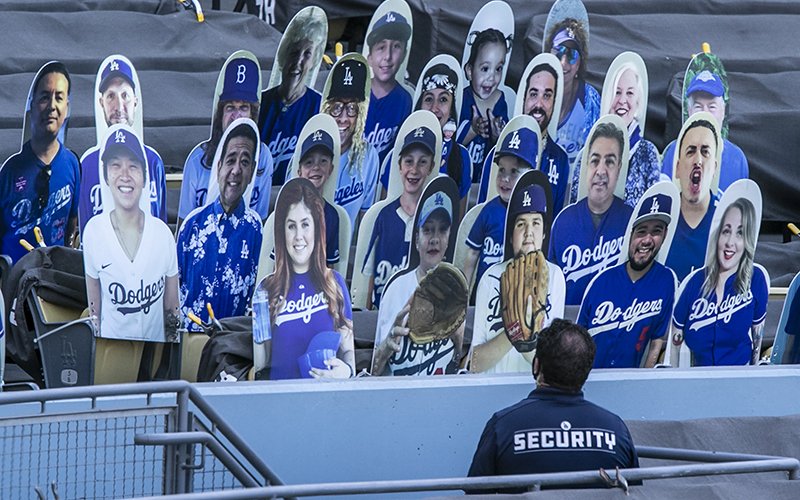Keep the 2020 MLB Rules Changes

After last year’s World Series ended, few of us were envisioning a 2020 season shortened due to a global pandemic. Nevertheless, here we are, and Major League Baseball is a horse of a different color this year.
Gone are many of the authentic sights and sounds of the ol’ ballgame. Due to concerns about COVID-19, stadium-goers are noticeably absent from the stands. Cutouts of fans or computerized representations replace them on telecasts with crowd noise pumped in. Either way, many of us aren’t accustomed to mostly empty venues. You know, unless we happen to be Marlins fans, and in that case, may God have mercy on our souls.
But yes, this is unfamiliar territory for our national pastime, extending even to its rules of play. To accommodate the “new normal,” the 2020 MLB rules changes have modified the modus operandi in intriguing ways.
Three-Batter Minimum
Well in advance of this season, we knew that relievers in 2020 would need to face three batters or close out an inning—whichever comes first. From a fan perspective, the benefits seem perceptual more than anything. Limiting reliever swaps is theoretically designed to save time, a preoccupation for a league whose product gets criticized as slow-paced, perhaps unfairly.
However, the time saved is minimal compared to, say, umpteen foul balls launched out of play. While the rule change doesn’t completely negate strategy either, it does limit the ability of managers to mix and match as they please. At its core, baseball is about individual matchups. For the hardcore baseball fan, this potentially makes baseball a little less fun. Then again, there’s something to be said about having more versatile relievers overall, not to mention baseball was already trending away from specialized relievers.
Extra Innings
If MLB’s planned changes are of questionable efficacy and strategic whimsy, the alterations due to COVID-19 are more inspired.
One shift pioneered in other formats/leagues implemented in 2020 is the new extra innings rules that see each half-inning start with a runner on second base. Immediately, it raises the stakes for that inning. More importantly, it promotes scoring rather than a slog through inning after extra inning.
In addition, both teams must handle this bit of adversity, and moreover, it won’t apply for the postseason. If you’re a relief pitcher, it might not be your cup of tea. For baseball fans, meanwhile? It’s inherently exciting.
Universal DH
I know some baseball purists must be gritting their teeth over this one. A good friend of mine, a diehard Mets fan, has long derided the designed hitter as the refuge of the old or otherwise incapable of fielding. Others appreciate the quirkiness of having one league with the DH and the other without it. If nothing else, it gives analysts something to talk about in interleague contests. So there’s that.
If you’re like me, however, you embrace the universal DH because it means pitchers aren’t in the lineup. I get it—some pitchers can swing the bat. The Madison Bumgarners and Zack Greinkes of the world aside, watching hurlers at the dish is just painful. Simply put, I’d rather have more players stepping up to bat who know what they’re doing.
Besides, forcing pitchers to step up to bat, when not an exercise in futility, still exposes them to injury. The ball could hit their pitching hand when swinging. They could trip over first base. They could pull a hamstring. Sure, these things could happen to position players too, but they are more likely afflictions of someone whose main responsibility is pitching, not hitting and playing the field. Let’s keep pitchers on the mound and out of the batter’s box.
I’ve heard criticism of the 2020 MLB rules changes as making baseball feel “like Little League.” While a departure from the norm, to be sure, it’s not as if these modifications to play are degrading the game.
Rules in sports are subject to change. The NBA added the three-point line. The NHL abolished the two-line offside pass rule. The NFL has changed its standards on kickoffs and field goals/extra points umpteen times. Treating Major League Baseball rules as sacrosanct ignores the malleability of professional sports. To make matters worse, it invites criticism that baseball is too stuck in its ways.
Other elements of this season’s approach, haphazard and context specific as they may be, seem like boons for player safety. Limiting doubleheaders to seven innings apiece stands to limit the burden on bullpens. In general, playing less exposes players less, some of whom are paid very, very highly for their skills, to risk of injury. The 162-game regular season is a war of attrition and fatigue is likely a factor in many lopsided playoff series. There’s something to be said for a better, if less abundant, product.
To be fair, not all the rules and schedule changes are necessarily winners. Expanding the postseason to a 16-team format, for one, feels too permissive. The playoffs are by their nature meant to be exclusive. If a team gets off to a slow start, they might not make it. That’s OK. Better to err on the side of being too restrictive on who gets a shot at the championship. Making it to October (the playoffs are still in October, right?) should be a privilege.
Overall, however, keep the 2020 MLB rules changes. They’re different, yes, and in some cases, dramatic. But they also make the game more manageable and, well, fun. At the end of the day, that’s what baseball’s supposed to be about, right?
-Joe Mangano












